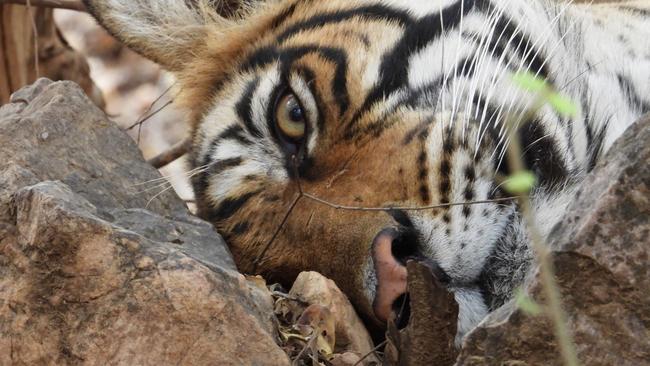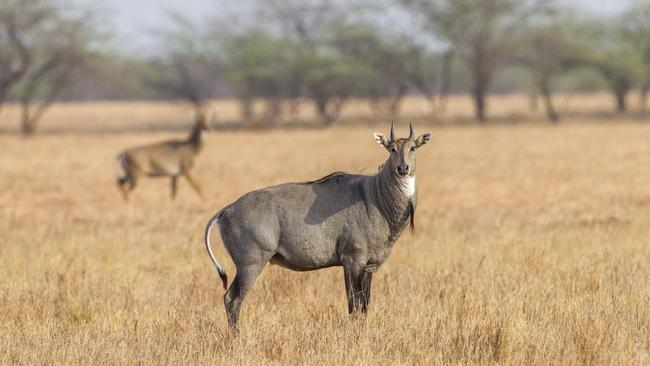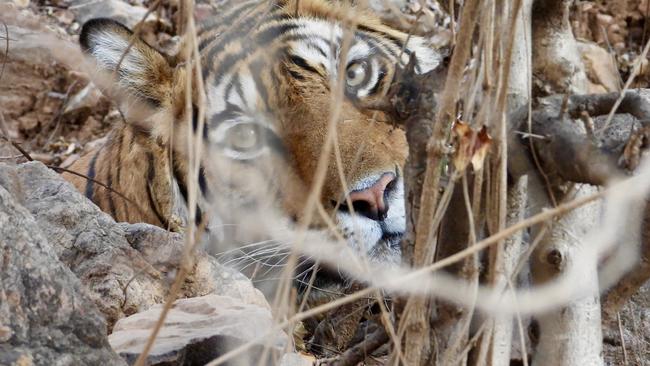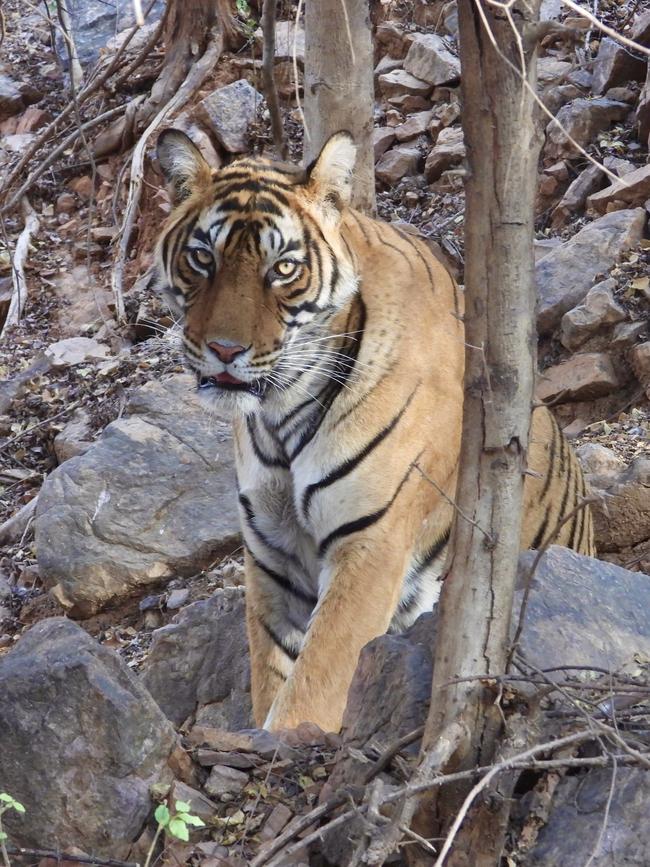Want to see a wild tiger? You have to earn your stripes
India’s Ranthambore National Park is home to more than 70 Bengal big cats. To spot one you’ll need patience and a lot of luck.

The paw print is clearly visible in the tangerine sand: one large pad with a semicircle of four smaller indentations at the top. I think of my own cat’s neat little bean toes. Although the feline connection between the two animals is undeniable, they are worlds apart. Here, in northern India’s Ranthambore National Park, the cats are big and they rule the roost. About 75 Bengal tigers, a number that is slowly growing, roam across 1700sq km of nature reserve, hunting abundant spotted deer and their more scruffy cousins known as sambars, plus nilgai, a curious-looking antelope that appears to be a cross between a Brahmin bull and Rudolph.
Tourists flock to Ranthambore, about 300km southwest of Agra, home to the Taj Mahal, in the hope of “bagging” a tiger. There are no guarantees, however. There are stories of visitors determinedly heading out on safari twice a day for a week without setting eyes on their prize.

This is not like an African game drive, where a failure to locate lions or elephants is well compensated with sightings of giraffe, zebra, gazelles, warthogs et al. If the tigers of Ranthambore don’t want to be seen, you may well return to your hotel disappointed.
That’s certainly how I feel after coming back from my first outing, part of a nine-day India tour with Luxury Gold. Our posse of eight rises before dawn to have cups of chai and biscuits before taking a rollicking ride in two jeeps under a pink sky to the national park. Safaris are tightly controlled affairs, with vehicles assigned by lottery to one of 10 sections of the park. We are sent to Zone 6 and spend more than three hours bumping and grinding up and down rocky slopes as the mercury gradually rises. On the cusp of summer, the park is parched, baking under a relentless sun that will soon bring temperatures well into the 40s. There’s little in the way of colour in this landscape apart from occasional flourishes of green near water sources and the short-lived orange blooms of the Flame of the Forest tree. By 9.30am we are coated in dust, deflated and desperate for cold drinks and a swim in our hotel pool.


Our naturalist guide, Rajesh Gujar, is a fifth-generation tiger tracker whose grandfather led the royal family of Jaipur on hunts before that gruesome pastime was officially banned in 1970. He tells us the cats are most active in the early morning and late afternoon, and might be found lying in wait for prey near a waterhole. The loud “bok” of a deer is often a warning sign that there’s a whiff of tiger in the air.
With the weather promising a scorching afternoon of sweat and grime, we return to the park. Our first port of call is a lengthy drive from the entrance, a waterhole deep within our newly assigned Zone 8. The ruling tigress in these parts, a three-year-old called Sharmilee, was spotted here earlier today. We find sambar beating the heat with a deep soak but Sharmilee is nowhere to be seen. Keen-eyed Rajesh finds paw prints leading away from the site and our pursuit begins. He believes the tigress is close but I admit I’m starting to feel despondent.

Our jeep takes a fork down a hillside, our companions in the vehicle behind, when suddenly there’s a shout. Tara, one of the guests in the second car, has locked eyes with the tigress, taking refuge in the shade just by the road. Tara is so shocked by her sudden and intimate face-to-face encounter she’s burst into tears. The 4WDs rev backwards up the hill and there she is, amid a screen of vines, her huge head resting on a pillow of sandstone. She’s less than 10m from us, and her green-gold eyes gaze at her audience impassively. She dozes, paws twitching with dreams of a hunt. Her pink nose gives off cute pussy-cat vibes, and then she opens her jaws wide in a yawn to reveal two enormous incisors and we’re reminded of her apex predator status.
How many pictures can you take of one animal? We spend about 40 minutes with Sharmilee and I snap more than 100 photos – close-ups of her nose and whiskers; those big paws; in slumber and awake; alert with ears radaring her surrounds; stretching out and seemingly oblivious to the fuss she’s attracted. After a while, five other jeeps arrive to share our bounty, and we make way and wait, hoping for a second look. When the others move on we return for a final audience with our queen. She rises up on her haunches and sits regally, observing the valley below. It’s then that we see the strength in her chest and shoulders, ripped muscles flexing under her silky coat. She could, at any point, launch herself easily into our vehicle, but we’re not to her taste.

Reluctantly, we bid her farewell. Rajesh is exultant: “We’re very lucky we saw her so close for so long … very rare sighting, very lucky.”
And our luck has not yet run out. As we approach the park exit, a guide in the jeep ahead waves for us to join him urgently. A leopard has come down from the hills to begin its nocturnal hunt. “Take a picture, take a picture,” Rajesh implores, but I’m unprepared and manage just one blurry frame of its spotted rear vanishing into the brush.
We’ve been extraordinarily fortunate to see two of Ranthambore’s big-ticket items in one afternoon. As the sun dips low, the jeeps squeeze through the park gates. A pack of foolhardy dogs trots in the opposite direction, apparently heading for the park. “Leopard food,” says Rajesh. “Yum, yum.”
In the know
Luxury Gold’s nine-day Essence of India itinerary includes two nights in a hotel at Ranthambore and two safari outings with an expert naturalist. The tour recommences in October, after summer and the wet season; from $6526 a person, twin-share.
Penny Hunter was a guest of Luxury Gold.
If you love to travel, sign up to our free weekly Travel + Luxury newsletter here.


To join the conversation, please log in. Don't have an account? Register
Join the conversation, you are commenting as Logout